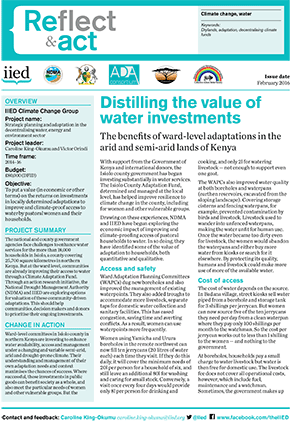Distilling the value of water investments

Created on Sep 13, 2024
The benefits of ward-level adaptations in the arid and semi-arid lands of Kenya
Objective:
To put a value (in economic or other terms) on the returns on investments in locally determined adaptations to improve and climate-proof access to water by pastoral women and their households.
Project Summary
The national and county government agencies face challenges to enhance water services for the more than 18,000 households in Isiolo, a county covering 25,700 square kilometres in northern Kenya. But at the ward level, communities are already improving their access to water through a Climate Adaptation Fund. Through an action research initiative, the National Drought Management Authority (NDMA) and IIED are exploring options for valuation of these community-driven adaptations. This should help communities, decision makers and donors to prioritise their ongoing investments.
Change in action
Ward-level committees in Isiolo county in northern Kenya are investing to enhance water availability, access and management under a changing and variable semi-arid, arid and drought-prone climate. Their understanding and management of their own adaptation needs and context maximises the chances of success. Where successful, these investments in public goods can benefit society as a whole, and also meet the particular needs of women and other vulnerable groups. But the benefits need to be captured and compared to enable economic decision makers to weigh one investment option against another.
Understanding these benefits should help communities, national agencies at various levels and donors to target and increase their investments in the public goods that they need most. A better understanding of benefits from the community’s adaptation priorities should also help local, national and international agencies improve the nature of their support for local adaptation and resilience-building.
Key Lessons Learnt & Innovations
- Adaptations prioritised by women and men included improved siting, design and management of water plans, shallow wells, sand dams and boreholes. Water users’ knowledge of the effects of climate variability within the dryland ecosystem enabled them to plan and predict the benefits of many adaptation activities effectively.
- Adaptation benefits included increased safe access to water, cost savings, economic opportunities and local capacity. Some, but not all, of these benefits could be quantified.
- Better use of past climate records, together with other hydrological information, could heighten the impact of investments. This information could also help communities identify their needs with local authorities, national technical services and private service providers.


